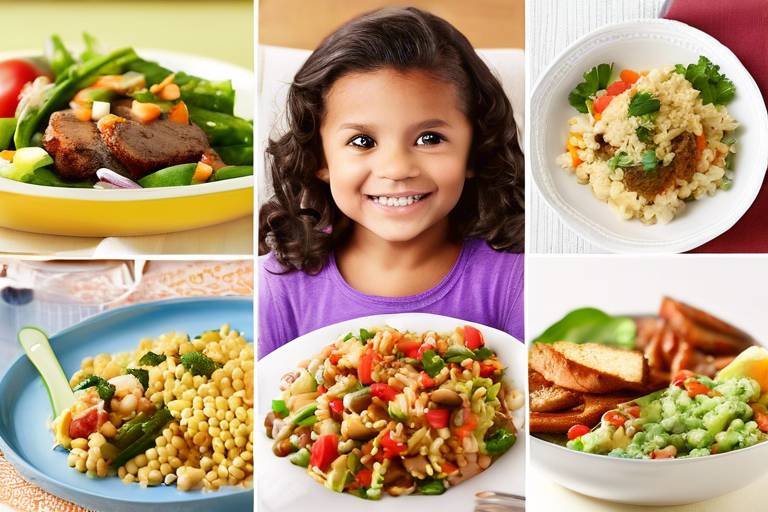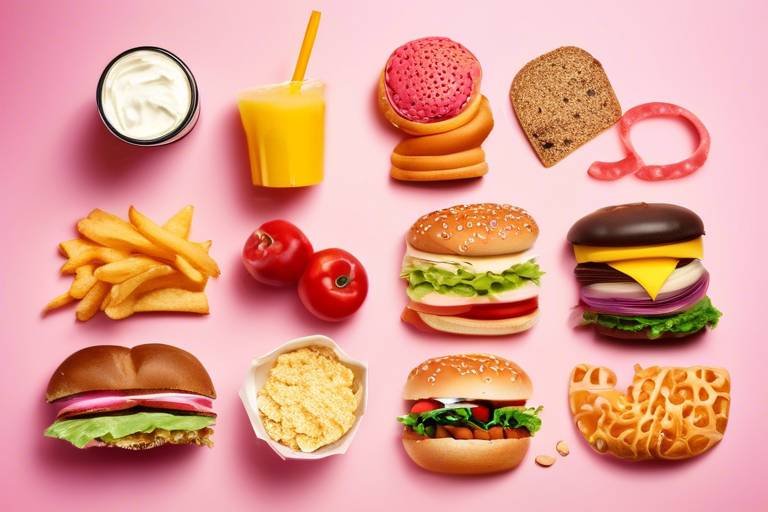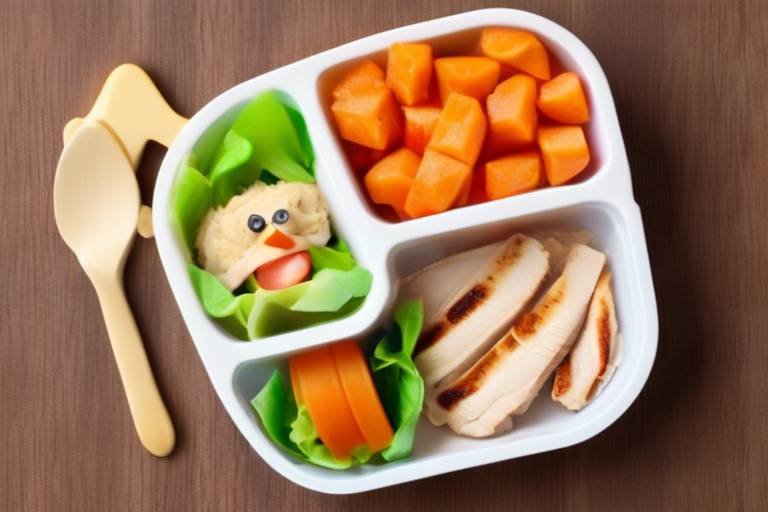Prepping and Serving Safe and Healthy Meals: A Guide for Parents
As parents, we all want the best for our children, and that includes providing them with nutritious meals that support their growth and development. But how do we navigate the vast world of food choices while ensuring that our kids are eating healthy and safe? This guide is here to help you master the art of meal prep and serving, making it easier to create delicious meals that your family will love, while keeping safety at the forefront.
First and foremost, it's essential to recognize that children's nutritional needs vary significantly with age. From toddlerhood through adolescence, their bodies require different amounts of vitamins, minerals, and macronutrients to thrive. For instance, infants need a diet rich in iron, while teenagers require more protein to support their growing muscles. By understanding these requirements, you can better balance their meals to ensure they receive the right nutrients. A good rule of thumb is to incorporate a variety of food groups into every meal, including fruits, vegetables, whole grains, and proteins, to create a well-rounded diet.
Meal planning is your secret weapon in promoting healthy eating habits. Not only does it save time during the week, but it also significantly reduces food waste. By taking a little time each week to plan out meals, you can ensure that your family is eating a balanced diet without the stress of last-minute decisions. Start by creating a weekly meal plan that includes breakfast, lunch, dinner, and snacks. This will allow you to shop efficiently and avoid the temptation of unhealthy convenience foods.
The concept of a balanced plate is a simple yet effective way to visualize what a healthy meal should look like. Aim to fill half of the plate with fruits and vegetables, a quarter with whole grains, and the remaining quarter with lean proteins. This method not only meets dietary guidelines but also ensures that your children are exposed to a variety of tastes and textures. For example, try serving grilled chicken with a side of quinoa and steamed broccoli, topped off with a fresh fruit salad.
Portion control is crucial in preventing overeating, especially for children. Their stomachs are smaller than ours, so it's important to serve appropriate portion sizes based on their age and activity level. A general guideline is to use the palm of their hand as a measurement for protein and carbohydrates, while filling the rest of the plate with vegetables. This approach not only helps them learn about portion sizes but also encourages them to listen to their bodies' hunger cues.
One of the biggest challenges in maintaining healthy eating habits is keeping meals exciting. Children can quickly become bored with the same foods, leading to meal fatigue. To combat this, try incorporating a variety of colors, flavors, and textures into your meals. Experiment with different cooking methods, such as roasting, grilling, or steaming, and introduce new ingredients gradually. For instance, if your child loves pasta, consider swapping out traditional spaghetti for whole grain or vegetable-based noodles.
Snacks are an integral part of a child's diet, providing essential energy between meals. Instead of reaching for processed snacks, consider preparing quick and nutritious options at home. Some great ideas include:
- Yogurt with fresh fruit and a sprinkle of granola
- Veggie sticks with hummus
- Whole grain crackers with cheese
- Fruit smoothies made with spinach and yogurt
These snacks not only satisfy hunger but also contribute to their overall nutritional intake.
While preparing healthy meals is important, food safety should never be overlooked. Understanding the basics of food safety can help minimize the risk of foodborne illnesses. Always wash your hands before handling food, and ensure that all surfaces and utensils are clean. When cooking, be mindful of cross-contamination by using separate cutting boards for raw meats and vegetables.
Proper food storage is essential in maintaining food quality and safety. Leftovers should be refrigerated within two hours of cooking and stored in airtight containers. Be sure to label them with the date to track freshness. Foods like fruits and vegetables should be kept in the crisper drawers of your fridge, while dry goods should be stored in a cool, dry place.
To ensure that your meals are safe to eat, familiarize yourself with the recommended cooking temperatures for various foods. For example, poultry should reach an internal temperature of 165°F, while ground meats should be cooked to at least 160°F. Using a food thermometer is the best way to guarantee that your meals are safe and free from harmful pathogens.
Fostering healthy eating habits in children is a journey that requires patience and creativity. One of the best ways to encourage these habits is by involving your kids in the cooking process. Not only does this boost their confidence, but it also teaches them valuable nutrition and food preparation skills. Consider setting aside time each week for a family cooking night, where everyone can pitch in and create a meal together.
When children help out in the kitchen, they are more likely to try new foods and develop a positive relationship with healthy eating. Assign age-appropriate tasks, such as washing vegetables, measuring ingredients, or stirring pots. This hands-on experience can spark their interest in food and nutrition, making them more adventurous eaters.
Lastly, don't forget to make mealtime fun! Creative ideas, such as themed dinners or interactive food presentations, can make healthy eating more engaging for kids. For example, you could have a taco night where everyone builds their own tacos with a variety of toppings. This not only encourages them to try new ingredients but also turns mealtime into a fun family activity.
Q: How can I get my picky eater to try new foods?
A: Patience is key! Offer new foods alongside familiar favorites, and encourage them to take just one bite. Sometimes, it takes multiple exposures before a child is willing to try something new.
Q: What are some healthy alternatives to sugary snacks?
A: Opt for naturally sweet options like fruits, yogurt with honey, or homemade energy bars made from oats and nut butter.
Q: How can I teach my kids about nutrition?
A: Involve them in grocery shopping, cooking, and discussing the benefits of different foods. Use fun facts and visuals to make learning about nutrition enjoyable!

Understanding Nutritional Needs
When it comes to ensuring our children grow up healthy and strong, understanding their nutritional needs is paramount. Each age group has unique requirements that play a crucial role in their growth and development. For instance, toddlers need a diet rich in calcium and iron to support their rapidly developing bones and blood cells, while older children might require more protein to sustain their energy levels during physical activities. It’s essential to balance their meals with a variety of foods that provide the necessary vitamins and minerals.
As a parent, you might wonder, "How do I know what's best for my child?" A good rule of thumb is to aim for a balanced diet that includes:
- Fruits and Vegetables: Aim for a colorful plate; the more colors, the more nutrients!
- Whole Grains: Choose whole grain bread, pasta, and cereals for fiber and energy.
- Protein Sources: Incorporate lean meats, fish, beans, and nuts to support muscle growth.
- Dairy: Provide milk, yogurt, and cheese for calcium and vitamin D.
It’s also important to note that children’s appetites can vary significantly from one day to another. This fluctuation is completely normal and can be influenced by factors such as their activity level, growth spurts, and even the weather! As a parent, it’s crucial to stay attuned to these changes and offer a wide range of options without pressure. Creating a positive mealtime environment can encourage children to explore new foods and develop healthy eating habits that last a lifetime.
Let’s break down the nutritional needs by age group to give you a clearer picture:
| Age Group | Key Nutrients | Recommended Foods |
|---|---|---|
| 1-3 years | Calcium, Iron, Protein | Milk, Yogurt, Soft-cooked vegetables, Lean meats |
| 4-8 years | Calcium, Protein, Fiber | Cheese, Whole grain bread, Fruits, Fish |
| 9-13 years | Protein, Iron, Vitamins A and C | Chicken, Spinach, Berries, Nuts |
| 14-18 years | Protein, Calcium, Iron | Eggs, Fortified cereals, Lean beef, Green leafy vegetables |
In summary, understanding your child’s nutritional needs is about more than just feeding them; it’s about laying the foundation for a healthy lifestyle. By providing a diverse and balanced diet, you’ll help them build a strong, healthy body and develop a positive relationship with food that can last a lifetime.
Q: How can I encourage my child to try new foods?
A: Involve them in meal preparation, make it fun, and offer foods in different forms (like raw, cooked, or blended). Be patient and keep offering new foods without pressure.
Q: What if my child is a picky eater?
A: It’s common for kids to be picky! Focus on providing a variety of options and let them choose what they want to eat. Avoid making a big deal out of it, and keep mealtimes positive.
Q: How do I know if my child is getting enough nutrients?
A: Regular check-ups with a pediatrician can help monitor their growth and nutrition. You can also keep a food diary to ensure they’re eating a balanced diet.

Meal Planning Basics
Meal planning is like having a roadmap for your family's nutrition journey. It helps you navigate through the chaos of daily life while ensuring that your loved ones are eating healthy, balanced meals. Think of it as your secret weapon against the dreaded "What's for dinner?" question that can strike panic into any parent's heart. By taking the time to plan out meals, you not only promote healthy eating habits but also save time and money, and reduce food waste.
So, how do you get started with meal planning? First, consider your family's dietary needs and preferences. Every family is different, and what works for one may not work for another. Take a moment to jot down your family's favorite meals, and don't forget to include some nutritious options. You might be surprised at how many delicious meals can be both healthy and loved by your kids!
Next, it's crucial to create a balanced weekly meal plan. This involves incorporating a variety of food groups to ensure that everyone is getting the nutrients they need. A good rule of thumb is to fill half of your plate with fruits and vegetables, a quarter with lean proteins, and the remaining quarter with whole grains. Here's a simple breakdown of what a balanced meal could look like:
| Food Group | Examples |
|---|---|
| Fruits | Apples, Bananas, Berries |
| Vegetables | Broccoli, Carrots, Spinach |
| Proteins | Chicken, Fish, Beans |
| Whole Grains | Brown Rice, Quinoa, Whole Wheat Bread |
Once you have your meals planned out, it’s time to create a shopping list. This is where the magic happens! By having a list, you can avoid impulse buys and ensure that you have all the ingredients you need for the week ahead. Plus, shopping with a list can make grocery trips quicker and more efficient, leaving you with more time to spend with your family.
Finally, don’t forget to be flexible. Life happens, and sometimes your plans might need to change. If your kids suddenly decide they don’t want broccoli on Tuesday, it’s perfectly okay to swap it out for a different vegetable. The goal is to create a system that works for you and your family, not to add stress to your life.
In summary, meal planning is a fantastic tool for parents to ensure that their families are eating healthy while also saving time and reducing waste. By understanding your family's nutritional needs, creating a balanced meal plan, and being flexible, you can make mealtime a stress-free and enjoyable experience for everyone.
- How do I get my kids involved in meal planning? You can start by asking them what they would like to eat and including them in the grocery shopping process. This not only gives them a sense of ownership but also makes them more likely to try new foods.
- What if I don’t have time to meal prep? Consider starting small. You can plan just a few meals for the week or prep ingredients rather than full meals. Even a little bit of planning can go a long way!
- How can I ensure my meals are balanced? Use the plate method as a guideline: fill half your plate with fruits and vegetables, a quarter with proteins, and a quarter with whole grains to create a balanced meal.

Creating a Balanced Plate
Creating a balanced plate is crucial for ensuring that your children receive the right mix of nutrients they need for their growth and development. Imagine your plate as a canvas where each food group adds color, texture, and essential nutrients to the masterpiece of a healthy meal. The goal is to incorporate a variety of food groups into each meal, making it not only nutritious but also visually appealing and satisfying.
To start, let’s break down the components of a balanced plate. A typical meal should ideally consist of:
- Fruits and Vegetables: These should take up about half of the plate. They are packed with vitamins, minerals, and fiber. Aim for a rainbow of colors to ensure a wide range of nutrients. For instance, you might include leafy greens, colorful bell peppers, and a serving of fresh fruit.
- Whole Grains: About a quarter of the plate should be dedicated to whole grains like brown rice, quinoa, or whole-grain pasta. These provide energy and are rich in fiber, which aids digestion and helps kids feel full.
- Protein: The remaining quarter should focus on protein sources. This can include lean meats, fish, eggs, beans, or tofu. Protein is essential for growth, muscle development, and overall health.
But how do you ensure your little ones are excited about these food groups? It’s all about presentation and involvement. Encourage your children to help with meal prep. When they have a hand in choosing and preparing the ingredients, they are more likely to be interested in eating them. Consider using cookie cutters to shape fruits and vegetables into fun designs or creating colorful skewers with their favorite proteins and veggies.
Moreover, don’t forget the importance of hydration! While it may not fit on the plate, serving water or milk alongside meals is essential. Encourage your kids to drink water regularly, especially if they’re active. This aids in digestion and keeps them energized throughout the day.
As you work towards creating balanced meals, remember that variety is key. Children can quickly become bored with the same foods, so rotating different fruits, vegetables, and proteins can keep meals exciting. For instance, if you had grilled chicken one night, consider swapping it for baked fish or a vegetarian option the next. This not only keeps their taste buds engaged but also introduces them to a broader spectrum of nutrients.
Finally, make mealtime a family affair. Eating together allows for conversations about food, nutrition, and healthy choices. It’s a fantastic opportunity to teach your children about the importance of balanced meals in a relaxed setting. By modeling healthy eating habits, you're instilling lifelong lessons that will benefit their well-being.
Q: How can I encourage my child to eat more vegetables?
A: Make vegetables fun! Use colorful plates, create veggie art, or involve them in the cooking process. The more they see and interact with vegetables, the more likely they are to try them.
Q: What if my child is a picky eater?
A: Picky eating is common. Keep offering a variety of foods without pressure. Sometimes it takes multiple exposures to a new food before a child is willing to try it. Patience is key!
Q: How can I ensure my child is getting enough protein?
A: Include a variety of protein sources in their diet. Incorporate beans, nuts, dairy, and lean meats. You can also sneak protein into snacks, like yogurt or nut butter on whole-grain toast.

Portion Sizes for Kids
When it comes to feeding our little ones, understanding portion sizes is crucial. It's not just about what they eat but also how much they eat. The right portion sizes can help prevent overeating and ensure that children get the essential nutrients they need for their growth and development. But how do we determine what a proper portion looks like for kids? It can be a bit tricky, considering their appetites can vary greatly from day to day.
One effective way to gauge portion sizes is to use the “plate method.” This method involves dividing a plate into sections to visualize how much of each food group should be included in a meal. For example, half of the plate should be filled with fruits and vegetables, one-quarter with whole grains, and the remaining quarter with protein. This not only helps in maintaining a balanced diet but also teaches children about healthy eating habits in a fun and engaging way.
To give you a clearer idea, here’s a simple table that outlines some recommended portion sizes for kids based on age:
| Age Group | Fruits & Vegetables | Grains | Protein |
|---|---|---|---|
| 2-3 years | 1 cup | 1 ounce | 1 ounce |
| 4-8 years | 1-1.5 cups | 1-2 ounces | 2-3 ounces |
| 9-13 years | 1.5-2 cups | 2-3 ounces | 4-5 ounces |
It's also important to consider the activity level of your child. Active kids may require larger portions to fuel their energy needs, while less active children might need smaller servings. A good rule of thumb is to encourage children to listen to their bodies. Teach them to eat until they are satisfied, not stuffed. This practice can help establish a healthy relationship with food from an early age.
Another aspect to consider is the visual cues for portion sizes. For instance, a serving of meat should be about the size of a child’s palm, while a serving of pasta can be compared to a fist. By using these simple analogies, children can better understand what appropriate portions look like without the need for constant measuring.
Finally, remember that every child is unique, and their needs may differ. It's always a good idea to consult with a pediatrician or a nutritionist to tailor portion sizes to your child's specific needs. By focusing on appropriate portion sizes, you’re not just filling their tummies; you’re also setting the stage for a lifetime of healthy eating habits.
Q: How can I tell if my child is eating enough?
A: Look for signs of growth and development, such as increased energy levels, healthy weight gain, and the ability to engage in physical activities. Regular check-ups with a pediatrician can also help monitor their nutritional needs.
Q: What should I do if my child refuses to eat certain foods?
A: It's normal for kids to be picky eaters. Keep offering a variety of foods without pressure. Sometimes it takes multiple exposures before they will try something new.
Q: How can I encourage my child to eat more fruits and vegetables?
A: Make fruits and vegetables fun! Involve them in shopping and cooking, and present the food in creative ways. For example, make a fruit salad with a rainbow of colors or use cookie cutters to shape vegetables.

Incorporating Variety
When it comes to keeping our little ones interested in healthy eating, variety is the secret sauce! Just like a painter needs a palette of colors to create a masterpiece, we need a range of foods to make meals exciting and nutritious. Children can be notoriously picky eaters, and if we serve the same meals over and over, we risk them turning their noses up at even the healthiest options. So, how do we spice things up in the kitchen? One effective strategy is to incorporate a mix of textures, flavors, and colors into each meal.
Imagine a plate filled with vibrant reds, greens, and yellows. Not only does it look appealing, but it also signifies a range of nutrients. For instance, consider mixing crunchy carrots, sweet bell peppers, and leafy greens. Each of these foods brings something unique to the table, from vitamins to fiber. It's like a mini celebration of health on a plate! You can also experiment with different cooking methods; try steaming, roasting, or grilling to bring out different flavors in the same ingredient. For example, roasted broccoli has a completely different taste and texture compared to steamed broccoli, and kids might be more inclined to give it a try.
Another fun way to introduce variety is through themed meals. Perhaps one night could be "Taco Tuesday," where you offer different toppings like beans, cheese, salsa, and guacamole. This not only allows children to customize their meals but also opens the door to trying new ingredients. You might be surprised at what they’ll enjoy! Additionally, consider incorporating international dishes that feature unique spices and flavors. A simple stir-fry with a variety of vegetables and a splash of soy sauce can transport your family to a different cuisine without leaving your kitchen.
Don't forget about the power of dips and sauces! Kids love to dip their food, and offering a selection of healthy dips can make vegetables more appealing. Think hummus, yogurt-based dressings, or even guacamole. These can be fun additions that encourage kids to explore new flavors while still getting their daily dose of veggies.
Finally, remember that variety doesn’t just apply to the main meals. Snacks can also be an opportunity to mix things up! Instead of the usual apple slices, why not try some sliced kiwi or a handful of mixed nuts? The more options you present, the more likely your child is to find something they love. So, let’s get creative in the kitchen and turn mealtime into a fun adventure filled with colorful, nutritious foods!
Q: How can I make sure my child is getting enough variety in their diet?
A: Aim to include a rainbow of colors on their plate, and try to introduce at least one new food each week. Involve them in choosing what to eat and preparing the meals, as this can increase their interest in trying new things.
Q: What are some easy ways to introduce new foods?
A: Start by mixing new foods with familiar ones. For example, add a new vegetable to their favorite pasta dish or blend a new fruit into a smoothie. Gradually increasing exposure can help them become more comfortable with new flavors.
Q: How can I encourage my child to eat more fruits and vegetables?
A: Make fruits and vegetables fun! Create colorful fruit skewers, offer dips for veggies, or involve them in the cooking process to make it more engaging. The more involved they feel, the more likely they are to enjoy eating healthy foods.

Healthy Snack Options
As parents, we often find ourselves in a constant battle against unhealthy snacks that seem to lurk around every corner. But fear not! There are plenty of wholesome and delightful snack options that can keep your kids satisfied and energized without compromising their health. Think of snacks as mini-meals that can contribute to your child’s overall nutrition. So, what can you whip up in the kitchen that’s both tasty and nutritious?
First off, let’s talk about fruits and vegetables. These are nature’s candy! Fresh fruits like apples, bananas, and berries are not only sweet and satisfying but also packed with essential vitamins and minerals. Pairing them with a little nut butter or yogurt can transform an ordinary snack into a nutrient powerhouse. For veggies, consider crunchy carrot sticks, cucumber slices, or bell pepper strips. Dip them in hummus or guacamole for an added flavor punch that your kids will love.
Another fantastic option is whole grains. Whole grain crackers or rice cakes topped with a slice of cheese can make for a quick and filling snack. They provide fiber, which is crucial for digestion and helps keep your little ones feeling full longer. You might also want to try making homemade popcorn. It’s a fun and interactive snack that you can flavor with a sprinkle of cheese or a dash of cinnamon for a sweet twist.
Now, let’s not forget about the power of protein! Snacks that include protein can help your kids feel more satisfied and maintain their energy levels. Consider offering hard-boiled eggs, Greek yogurt, or even a handful of nuts (if allergies aren’t a concern). These options are not only delicious but also support muscle growth and repair, which is essential for active children.
For a quick reference, here’s a
| Snack Type | Examples | Nutritional Benefits |
|---|---|---|
| Fruits | Apples, Bananas, Berries | Rich in vitamins, minerals, and fiber |
| Vegetables | Carrot sticks, Cucumber slices | Low in calories, high in nutrients |
| Whole Grains | Whole grain crackers, Popcorn | High in fiber, promotes fullness |
| Protein | Hard-boiled eggs, Greek yogurt | Supports muscle growth and energy |
Incorporating variety into your snack routine is vital to keep things interesting. Kids can be picky, and the last thing you want is for them to get bored with healthy options. Try rotating different snacks each week or even creating a “snack jar” filled with assorted healthy treats. Let them choose what they want, giving them a sense of control over their food choices.
Finally, remember that making snacks a fun experience can also encourage healthier eating habits. Involve your kids in the preparation process! Let them help wash fruits, mix ingredients, or even create their own snack combinations. This not only teaches them valuable skills but also fosters a positive relationship with food. After all, when children are part of the cooking process, they are more likely to eat what they’ve made!
1. What are some quick healthy snacks for kids?
Some quick and healthy snacks include sliced fruits, yogurt, whole-grain crackers, and veggie sticks with hummus.
2. How can I encourage my kids to eat healthier snacks?
Involve them in the snack-making process and offer a variety of colorful and fun options to keep their interest piqued.
3. Are there any snacks I should avoid?
Try to limit snacks that are high in sugar, salt, and unhealthy fats. Instead, focus on whole foods that provide essential nutrients.

Food Safety Practices
When it comes to preparing meals for your family, food safety should always be at the forefront of your mind. After all, what good is a nutritious meal if it can lead to foodborne illnesses? Understanding the essential practices of food safety can make all the difference in ensuring that your loved ones stay healthy and happy. One of the key principles is proper food handling, which includes washing your hands thoroughly before and after handling food, especially raw meat and poultry. Think of your hands as the first line of defense against germs, and always treat them as such!
Another critical aspect is cooking food to the right temperatures. Many parents may not realize that different foods have different safe cooking temperatures. For instance, ground meats should reach an internal temperature of 160°F, while poultry should be cooked to 165°F. Using a food thermometer can help you avoid the guesswork and ensure that your meals are safe to eat. Imagine biting into a juicy chicken breast, only to find it undercooked—yikes! To help you remember these temperatures, here’s a handy table:
| Food Type | Safe Cooking Temperature (°F) |
|---|---|
| Ground Meats | 160 |
| Poultry | 165 |
| Beef, Pork, Lamb (Steaks, Roasts, Chops) | 145 |
| Fish | 145 |
After cooking, it’s equally important to store leftovers properly. Leftovers should be refrigerated within two hours of cooking to prevent bacteria growth. When storing, use airtight containers to keep food fresh and prevent cross-contamination. You wouldn’t want your delicious spaghetti to taste like last week’s fish, right? Labeling containers with dates can also help you keep track of how long food has been stored. This simple habit can save you from potential food spoilage and waste.
Additionally, always remember to separate raw foods from cooked ones. This practice, known as cross-contamination, can be a sneaky culprit in foodborne illnesses. Use separate cutting boards for raw meats and vegetables, and never place cooked food on a plate that previously held raw ingredients without washing it first. It's like keeping your clean laundry away from the dirty pile—nobody wants to mix the two!
By following these food safety practices, you can create a safe kitchen environment that protects your family’s health. It’s not just about cooking; it’s about cooking smart. So, roll up your sleeves, put on your apron, and let’s keep those food safety practices in check!
- What is the most important food safety practice? Washing hands thoroughly before and after handling food is crucial.
- How can I tell if my food is cooked properly? Using a food thermometer is the best way to ensure your food reaches safe temperatures.
- How long can I keep leftovers in the fridge? Leftovers should be eaten within 3-4 days to ensure safety and quality.
- What should I do if I suspect food poisoning? Seek medical advice and keep hydrated; report any suspected foodborne illness to your local health department.

Safe Food Storage
When it comes to keeping your family safe and healthy, food storage plays a crucial role. Proper food storage not only helps in maintaining the quality of your meals but also significantly reduces the risk of foodborne illnesses. Have you ever wondered how long you can keep that leftover lasagna in the fridge? Or what the best way to store fruits and vegetables is? Understanding the ins and outs of food storage can make a world of difference in your kitchen.
First things first, let's talk about refrigeration. The refrigerator is your best friend when it comes to preserving perishable items. Ideally, your fridge should be set at or below 40°F (4°C). This temperature slows down bacterial growth, keeping your food fresher for longer. Make it a habit to check your fridge's temperature regularly, just like you would check the oil in your car. A few degrees can mean the difference between a healthy meal and a potential health hazard.
Next, let’s dive into the storage hierarchy. Foods should be stored according to their type. For example, raw meats should always be kept on the bottom shelf to avoid dripping onto other foods. This simple step can prevent cross-contamination, which is a common cause of foodborne illnesses. Additionally, it’s wise to use airtight containers for storing leftovers. Not only do they keep your food fresh, but they also prevent odors from mingling. Who wants their leftover spaghetti tasting like last week’s fish, right?
Now, let’s not forget about the freezer! Freezing is a great way to extend the shelf life of many foods. However, it’s important to know that not all foods freeze well. Here’s a quick list of foods that freeze beautifully:
- Soups and stews
- Cooked grains like rice and quinoa
- Fruits, especially berries and bananas
- Vegetables, particularly when blanched first
On the flip side, there are some foods you should avoid freezing, such as lettuce and other high-water-content vegetables, which can become mushy upon thawing. Always label your containers with dates to keep track of how long they’ve been in the freezer. A simple sharpie can save you from some serious guesswork later on!
Finally, let’s talk about leftovers. They can be a lifesaver for busy parents, but they must be handled with care. Leftovers should ideally be consumed within 3 to 4 days of cooking. If you’re not planning to eat them within that timeframe, consider freezing them. When reheating, make sure to heat food to at least 165°F (74°C) to kill any potential bacteria. Think of it as a safety blanket for your meals!
In summary, safe food storage is all about being proactive. By understanding how to store your food properly, you can ensure that your family enjoys healthy and safe meals every day. Remember, it’s not just about what you eat, but how you store it that matters. So, next time you’re putting food away, think about these tips and keep your kitchen a safe haven for your family!
1. How long can I keep leftovers in the fridge?
Leftovers should generally be consumed within 3 to 4 days to ensure safety and quality.
2. What is the best way to store fruits and vegetables?
Store fruits and vegetables separately; keep fruits in a cool area and vegetables in the crisper drawer of the fridge. Use breathable bags for optimal freshness.
3. Can I refreeze food that has been thawed?
Yes, but only if it was thawed in the refrigerator and not left out at room temperature. Always ensure it’s cooked properly before refreezing.
4. How can I tell if food has gone bad?
Always check for off smells, discoloration, or any signs of mold. When in doubt, throw it out!

Cooking Temperatures
When it comes to preparing meals for your family, one of the most crucial aspects to consider is the cooking temperature. Ensuring that food is cooked to the right temperature not only enhances flavor but also significantly reduces the risk of foodborne illnesses. It's essential to understand that different types of food require different cooking temperatures to be safe for consumption. For instance, undercooked poultry can harbor harmful bacteria like Salmonella, while ground meats must reach a specific internal temperature to eliminate pathogens.
To help you navigate this vital aspect of meal preparation, here’s a handy table that outlines the recommended cooking temperatures for various types of food:
| Food Type | Recommended Cooking Temperature (°F) |
|---|---|
| Poultry (whole or ground) | 165°F |
| Beef, Pork, Lamb (steaks, roasts, chops) | 145°F |
| Ground meats (beef, pork, lamb) | 160°F |
| Fish and Shellfish | 145°F |
| Egg dishes | 160°F |
Using a food thermometer is the most reliable way to ensure that your meals are cooked to the appropriate temperature. Not only does this tool help you avoid guesswork, but it also provides peace of mind knowing that you’re serving safe food to your family. Insert the thermometer into the thickest part of the food, avoiding bone, and make sure it reads the correct temperature before serving.
Another important point to consider is the resting time. After cooking, allow meats to rest for a few minutes before cutting into them. This helps redistribute the juices and ensures that the internal temperature remains stable, further enhancing safety and flavor. For example, a roast should rest for at least 3 minutes after being taken off the heat.
In summary, understanding and adhering to proper cooking temperatures is a fundamental part of preparing safe meals. By being vigilant about cooking temperatures and using a food thermometer, you can ensure that your family enjoys delicious, healthy, and safe meals every time.
- What is the safest way to check cooking temperatures? The safest way is to use a food thermometer, which gives you an accurate reading of the internal temperature.
- Why is resting time important? Resting time allows the juices to redistribute throughout the meat, making it more flavorful and ensuring it remains at a safe temperature.
- Can I rely on color to determine if meat is cooked? No, color can be misleading. Always use a thermometer to ensure food is cooked to the right temperature.

Encouraging Healthy Eating Habits
When it comes to encouraging healthy eating habits in children, the approach can be as important as the food itself. It's not just about what they eat, but how they feel about eating. One of the most effective ways to foster a positive relationship with food is by making mealtime an enjoyable experience. Think about it: if kids associate mealtime with fun and creativity, they’re more likely to be open to trying new foods and embracing healthy choices. So, how can you turn the dinner table into a delightful experience?
First off, involving your kids in the cooking process can be a game changer. Not only does it boost their confidence, but it also teaches them valuable skills about nutrition and food preparation. When children help wash vegetables, stir sauces, or even measure ingredients, they develop a sense of ownership over their meals. This engagement can significantly increase their willingness to eat what they’ve helped create. Plus, it opens up opportunities for discussions about where food comes from and why certain ingredients are important for their health.
Now, let’s talk about making meals fun! You can transform ordinary dinners into exciting culinary adventures. For example, consider themed dinners where you explore different cuisines from around the world. One night could be Italian, featuring homemade pizzas with a variety of toppings, while another could be Mexican, with tacos that they can assemble themselves. This not only makes the meal interactive but also allows kids to experiment with flavors and textures. When children have the freedom to create their own meals, they’re more likely to try new ingredients and flavors.
Another effective strategy is to present food in a visually appealing way. Kids are naturally drawn to vibrant colors and fun shapes. You might create a 'rainbow plate' filled with fruits and vegetables of various colors, or use cookie cutters to make sandwiches into fun shapes. Engaging their senses can make the food more enticing. And don’t forget about the power of storytelling! Sharing a fun story about a particular dish or ingredient can spark their curiosity and make them more interested in trying it.
However, it’s also important to set a good example. Children are like sponges; they absorb behaviors from their parents. If they see you enjoying a variety of healthy foods, they are more likely to mimic that behavior. Make it a family affair by sitting down together for meals as often as possible. This not only strengthens family bonds but also creates a consistent routine around healthy eating. Remember, the goal is to cultivate an environment where healthy eating is the norm, not the exception.
To further encourage healthy eating habits, consider implementing a few ground rules that promote positive behavior around food. For example, you might establish a 'no screens at the table' policy to ensure that mealtime is focused on eating and conversation. Additionally, try to limit sugary snacks and drinks in the house so that when hunger strikes, healthier options are the most accessible. This doesn’t mean you can’t indulge occasionally; balance is key! Allowing treats in moderation can help children learn about making healthy choices without feeling deprived.
In conclusion, encouraging healthy eating habits in children is all about making food fun, engaging, and a shared experience. By involving them in cooking, creating themed meals, and setting a positive example, you can help instill a lifelong appreciation for nutritious foods. After all, healthy eating is not just a phase; it’s a lifestyle that can benefit them for years to come.
- How can I get my picky eater to try new foods? Start by introducing new foods alongside their favorites. Encourage them to take just one bite, and celebrate their willingness to try.
- What are some healthy snacks I can prepare for my kids? Consider options like sliced fruits, yogurt with granola, or veggie sticks with hummus. These are nutritious and easy to prepare!
- How often should I involve my kids in cooking? Try to involve them in cooking at least once a week. This can be a fun family activity that they look forward to!

Involving Kids in Cooking
Involving kids in cooking can be an absolute game changer for both parents and children alike! It’s not just about getting them to help out in the kitchen; it’s about creating an enriching experience that fosters a love for food and cooking. Imagine your little ones, apron-clad and ready to whip up something delicious! When children participate in meal preparation, they gain valuable skills that will last a lifetime. They learn to appreciate the effort that goes into cooking, which can lead to healthier eating habits down the line.
One of the most significant benefits of including kids in the cooking process is the boost in their confidence. As they measure ingredients, stir sauces, or chop vegetables (with supervision, of course), they gain a sense of accomplishment. It’s a bit like giving them a mini-master chef title! Plus, it opens the door for conversations about nutrition and where food comes from. You can talk about the importance of fresh ingredients and how they contribute to a healthy diet, making the experience both fun and educational.
Moreover, cooking together can transform mealtime into a bonding experience. Think of it as a family project where everyone contributes! You could designate tasks based on age and ability. For example, younger kids can wash vegetables or mix ingredients, while older children can take on more complex tasks like chopping or sautéing. This not only makes them feel involved but also teaches them teamwork and responsibility.
To keep things exciting, consider introducing themed cooking nights. For instance, you could have a "Taco Tuesday" where everyone gets to create their own taco masterpiece, or a "Pizza Night" where kids can choose their toppings. This interactive format encourages kids to experiment with different flavors and textures, making them more open to trying new foods. You might be surprised at how a simple cooking session can turn into a culinary adventure!
In addition to the fun, there are some practical aspects to consider when involving kids in the kitchen. Safety is paramount, so always supervise them closely, especially when handling sharp utensils or hot surfaces. Creating a kitchen safety checklist can be a great way to teach them the importance of being cautious while cooking. Here’s a simple example:
| Kitchen Safety Tips |
|---|
| Always wash your hands before cooking. |
| Use oven mitts when handling hot pots and pans. |
| Keep knives away from the edge of the counter. |
| Never leave cooking food unattended. |
By making cooking a regular family activity, you’re not only preparing meals together but also creating lasting memories. It’s these little moments that can spark a lifelong interest in cooking and healthy eating in your children. So, roll up those sleeves, grab those spatulas, and let the culinary adventures begin!
- What age should my child start cooking? Generally, kids can start helping in the kitchen as early as 2 or 3 years old with simple tasks. As they grow, you can introduce more complex cooking skills.
- How can I make cooking fun for my kids? Try themed cooking nights, let them choose recipes, or turn cooking into a game to keep them engaged and excited.
- Are there any safety tips I should follow? Yes! Always supervise your children, teach them about kitchen safety, and ensure they use age-appropriate tools.
- What if my child is a picky eater? Involving them in cooking can help them become more open to trying new foods, especially if they have a hand in preparing them.

Making Meals Fun
Let’s face it, getting kids excited about healthy meals can sometimes feel like trying to pull teeth. But what if I told you that making mealtime fun could transform the way your children view food? Instead of dreading dinner, they could be looking forward to it! The key is to sprinkle a little creativity and playfulness into your meal preparation. Think of mealtime as an adventure, where every bite is a new discovery, and you’re the captain of this culinary ship!
One fantastic way to make meals engaging is by introducing themed dinners. Imagine a "Taco Tuesday" where everyone can customize their own tacos with a variety of toppings. Not only does this empower kids to make choices, but it also gives them a sense of ownership over their meals. You can set up a taco bar with colorful ingredients like diced tomatoes, shredded lettuce, cheese, and guacamole, turning dinner into a fun assembly project. This approach not only promotes healthy eating but also encourages family bonding!
Another exciting idea is to create interactive food presentations. This could mean turning a simple fruit salad into a rainbow masterpiece. You can challenge your kids to create the most colorful plate possible, using different fruits and veggies. This not only makes the meal visually appealing but also encourages them to try new foods. You might be surprised at how many new favorites they discover when they’re the ones creating the plate!
Moreover, you could incorporate games into mealtime. For example, you might play a 'guess the ingredient' game where you prepare a dish and have the kids guess what’s inside. This can lead to discussions about nutrition and the benefits of various ingredients, making them feel like little food detectives! It’s a fun way to educate them while keeping them engaged.
Lastly, don’t underestimate the power of presentation. Kids are naturally drawn to fun shapes and colors. Use cookie cutters to create star-shaped sandwiches or fruit kebabs with a variety of colorful fruits. When food looks fun, kids are more likely to want to eat it. You could even have a 'dinner art' night where everyone creates their own edible masterpiece on their plates. The mess might be worth the joy it brings!
Incorporating these fun elements into meals can significantly change how children perceive healthy eating. It’s all about making food enjoyable and exciting. By transforming mealtime into a creative and playful experience, you’re not just feeding your children; you’re also instilling a lifelong appreciation for nutritious foods. So, get ready to unleash your inner chef and turn your kitchen into a playground of flavors!
- How can I get my kids to try new foods? Start with small portions and pair new foods with their favorites. Make it a game or a fun activity to encourage them to explore new tastes.
- What are some easy themed dinner ideas? Taco Tuesday, Pizza Night where everyone makes their own, or Breakfast for Dinner are great options!
- How important is presentation in getting kids to eat? Very important! Fun shapes, colors, and creative presentations can make a meal much more appealing to children.
Frequently Asked Questions
- What are the essential nutritional needs for children at different ages?
Children's nutritional needs vary significantly as they grow. Infants require a diet rich in breast milk or formula, while toddlers need a balanced mix of fruits, vegetables, grains, and proteins. School-age children and teenagers have increased energy needs, so it's crucial to provide them with meals that include adequate calories, vitamins, and minerals to support their growth and development.
- How can I effectively plan meals for my family?
Meal planning can save you time and reduce stress during busy weeks. Start by creating a weekly menu that includes a variety of food groups. Aim for balance by incorporating fruits, vegetables, whole grains, and proteins in each meal. Don’t forget to consider your family's preferences and any dietary restrictions. Planning ahead can also help minimize food waste and cut down on last-minute unhealthy choices!
- What does a balanced plate look like for kids?
A balanced plate for kids typically includes portions from all major food groups: half the plate should be filled with fruits and vegetables, a quarter with whole grains, and a quarter with protein sources like lean meats, beans, or dairy. This visual guide helps ensure that children receive a wide range of nutrients necessary for their growth.
- How do I determine appropriate portion sizes for my children?
Portion sizes for children can vary based on their age and activity level. A good rule of thumb is to serve them about one tablespoon of each food for every year of their age. Encourage them to listen to their hunger cues and allow them to ask for more if they are still hungry. This way, they learn to regulate their own eating habits.
- What are some healthy snack options for kids?
Healthy snacks can be both tasty and satisfying! Consider options like sliced fruits, yogurt, whole grain crackers with cheese, or veggies with hummus. Preparing these snacks at home can keep your kids energized without resorting to sugary or processed foods. Plus, involving them in the preparation can make it even more fun!
- What are the best practices for food safety at home?
Food safety is crucial to prevent foodborne illnesses. Always wash your hands before handling food, keep raw meats separate from other foods, and cook foods to the appropriate temperatures. Additionally, refrigerate leftovers promptly and store perishables properly to maintain freshness. Following these guidelines helps ensure that your family stays healthy.
- How can I involve my kids in cooking?
Involving kids in cooking can be a rewarding experience! Start with simple tasks like washing vegetables or stirring ingredients. This not only boosts their confidence but also teaches them essential life skills. Plus, it can be a great bonding activity that fosters a love for healthy eating!
- What are some creative ways to make meals fun for kids?
Making meals fun can encourage kids to try new foods! Consider themed dinners, like taco night or pizza-making parties, where they can customize their meals. You can also create fun shapes with fruits and veggies or let them assemble their own sandwiches. Engaging them in the process can turn mealtime into an enjoyable event!



















